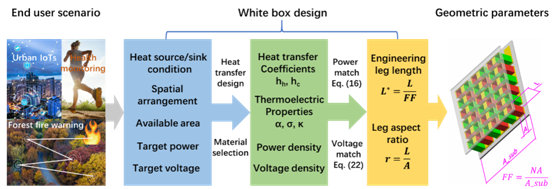A new set of formulas hasten the thermoelectric system design
Sep 25, 2020
Developments in thermoelectric energy harvesting techniques have tended to focus on the materials themselves. Many of those developments are centered on simplistic assumptions of the materials or determining thermal exchanges between different parts of the devices. Very few studies have thought to assess those assumptions to improve the efficiency of devices or the fundamentals behind thermoelectric system-level optimization.
With that in mind, Associate Professor Weishu Liu (Materials Science and Engineering) has led his research team to make vital progress in thermoelectric energy conversion design theory. Their paper, titled “System efficiency and power: the bridge between the device and system of a thermoelectric power generator,” was published in the high-impact academic journal, Energy & Environmental Science. The research team was aiming to form a bridge between thermoelectric materials, system design, and devices.

Figure 1 Typical waste heat utilization thermoelectric system. (a) System schematic diagram; (b) System thermal resistance network
Significant efforts have been put into understanding thermoelectric conversion, the process of converting heat energy into electrical energy, and vice versa. There are numerous promising applications for this technology. The research in this field is spread between the materials, the devices, and systems design. The majority of the research has focused on the materials. However, further research is needed into the devices and system design to realize the commercial application thermoelectric conversion technology.
Research into devices has not significantly changed since the 1950s. It is based on the same theoretical framework designed by Soviet Union scientist Ioffe of that era. The existing formulae also lack the flexibility to deal with new and more modern materials. For a real application scenario, it is needed to include the effect of the thermal resistance among the heat source, device, and heat sink. There is a need to design calculative methods that show researchers how their variables affect different aspects of their design and devices.

Figure 2 Theoretical framework of thermoelectric system design for terminal application scenarios
To deal with this problem, the research team took a new approach to calculation, rather conventional numerical calculation route. They sought to develop a series of formulae that would allow scholars to input and change variables while seeing how those changes impact other areas of their calculations. Based on the fundamental control equations and actual thermal boundary conditions, the researchers deduced the first set of explicit theoretical calculation formulas for the energy conversion efficiency and output power of the thermoelectric system.
Their white-box approach to thermoelectric energy conversion formulas created a bridge between connecting material scientists and thermal engineers. It offers researchers around the world with a future-forward process to evaluate the performance of their designs with a new fundamental basis.
Postdoctoral researcher Kang Zhu is the first author of the paper. Dr. Weishu Liu is the corresponding author. SUSTech is the corresponding unit.
This work received support from the SUSTech-MIT Mechanical Engineering Education and Research Center, the Guangchuang Team Project, the Shenzhen Science and Technology Foundation, and the Tencent Public Welfare Foundation “Science Exploration Award” project.
The original link: https://newshub.sustech.edu.cn/html/202009/27983.html
Latest News
Related News












